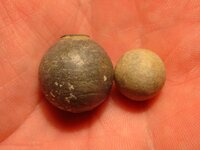Swartzie
Hero Member
- Mar 15, 2009
- 791
- 52
- Detector(s) used
- Tesoro Tejon
- Primary Interest:
- Relic Hunting
I dug these two balls within feet from each other. The larger one looks pretty modern from what I can tell and the smaller one looks old with the white patina on it. Since they were so close to each other I'm wondering if maybe the larger one is actually older than it looks. Perhaps maybe a buck and ball combination or something like that. The larger one measures about .75 inches and the smaller measures about .5 inches (I do need to get a pair of calipers sometime). Also, the smaller one is completely smooth with no visible sprue tip. Both balls also have no mold lines visible. Any thoughts?
Thanks.
-Swartzie
Thanks.
-Swartzie







